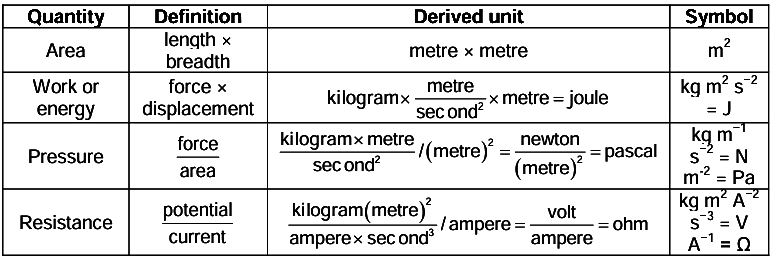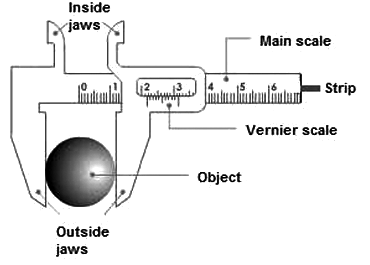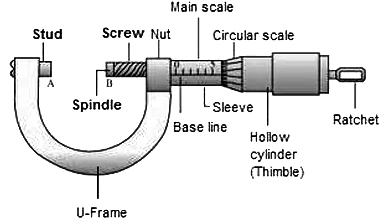Class 9 Exam > Class 9 Notes > Physics Class 9 ICSE > Revision Notes: Measurements And Experimentation
Revision Notes: Measurements And Experimentation | Physics Class 9 ICSE PDF Download
Need of Unit for Measurement
- Measurement is the process of comparison of the given physical quantity with the known standard quantity of the same nature.
- A unit is the quantity of a constant magnitude which is used to measure the magnitudes of other quantities of the same nature.
- The magnitude of a physical quantity is expressed as
Physical quantity = numerical value × unit - A unit can be chosen if it has appropriate properties.
Kinds of Units
- Fundamental or basic unit: A fundamental unit is that which is independent of any other unit or which can neither be changed nor be related to any other fundamental unit.
- Derived units: Derived units are those which depend on the fundamental units or which can be expressed in terms of the fundamental units.
Examples of Derived Units

Systems of Units
- There are three systems of units used worldwide. They are CGS, FPS and MKS.
- CGS system or French system: The unit of length is centimetre, the unit of mass is gram and the unit of time is second.
- FPS system or British system: The unit of length is foot, the unit of mass is pound and the unit of time is second.
- MKS system or Metric system: The unit of length is metre, the unit of mass is kilogram and the unit of time is second.
- Systeme Internationale d’unites or SI system
According to this system, there are nine fundamental units, including two angular units.
- For expressing large or small numbers/amounts, prefixes are used.
Units of Length
- The SI unit of length is metre (m).
- A metre is defined as the distance which light travels in (1/299,792,458) of a second in air or vacuum.
Sub-units of Metre
- Centimetre, millimetre, micrometre or micron and nanometre.
Non-metric Units of Length
Bigger Units
- Astronomical unit (AU): One astronomical unit is equal to the mean distance between the Earth and the Sun.
- 1 A.U = 1.496 x 1011 m ≈ 1.5 x 1011 m
Light year (ly): A light year is the distance travelled by light in vacuum in one year.
1 ly = 9.46 x 1012 km
Parsec: One parsec is the distance from where the semi-major axis of the orbit of the Earth subtends an angle of 1” (one second) at the centre of the Sun. One parsec is 3.26 light years.
1 parsec = 3.08 x 1016 m
Smaller Units
- Angstrom
 = 10-8 cm = 10-9 nm
= 10-8 cm = 10-9 nm - fermi (f): 1f = 10-15 m
Units of Mass
- The SI unit of mass is kilogram (kg).
- One kilogram is defined as the mass of a cylindrical piece of platinum–iridium alloy kept in International Bureau of Weights and Measures at Sevres near Paris.
The sub-units of kilogram are gram (g) and milligram (mg).
The non-metric unit of mass is atomic mass unit (amu) or the unified atomic mass unit (u).
- 1 a.m.u = (1/12)th the mass of one carbon-12 atom
Units of Time
- The SI unit of time is second (s).
- A second is defined as (1/86,400)th part of a mean solar day.
1s = (1/86,400) x one mean solar day - In 1964, one second was defined as the time interval of 9,192,631,770 periods of a specified energy change in the cesium-133 atom.
Common Units of Time
- Minute (min), Hour (h), Day, Month, Lunar month, Year, Leap year, Decade, Century and Millennium.
Guidelines for Writing Units
- The symbol of a unit, which is not named after a scientist, is written in lower case.
- The symbol of a unit, which is named after a scientist, is written with the first letter of his name in capital.
- The full name of a unit, even when it is named after a scientist, is written with a lower initial letter.
- A compound unit formed by multiplication of two or more units is written after putting a dot, cross or leaving a space in between the two symbols.
- A negative power is used for compound units, which are formed by dividing one unit by the other.
- A unit in its short form is never written in plural.
Least Count of a Measuring Instrument
- The least count of an instrument is the smallest measurement which can be taken accurately with it.
- The least count of an instrument is the value of the smallest division on its scale.
- Smaller the least count of an instrument, the more accurate the measurement
Measurement of Length with a Metre Scale
- A metre scale is a scale with length one metre which is graduated in cm and has subdivisions in mm. There are 10 subdivisions in each cm.
- The value of one small division on the metre scale is 1 mm. Thus, its least count is 1 mm.
- Precautions should be taken while measuring the length of an object.
- The limitation of a metre scale is that it can measure the length correctly up to one decimal place of a centimetre.
Principle of Vernier
- Two scales are used in this technique. One is the main scale, and the other is called the vernier scale.
- The least count of vernier is equal to the difference between the values of one main scale division and one vernier scale division. This is called the vernier constant.
- ‘n’ divisions of vernier are equal to n−1 divisions of the main scale. Therefore, the value of one division of vernier =


Vernier Callipers
- A vernier calliper is also called a slide calliper.

- The main parts of vernier callipers and their functions are given below.

- The least count of a vernier calliper is given as

- Zero error in vernier callipers: The zero error is equal to the distance between the zero of the main scale and the zero of the vernier scale.
- Kinds of zero error
- There are two kinds of zero error—positive and negative zero error.
- Positive zero error: When the zero mark of the vernier scale is on the right of the zero mark of the main scale, the zero error is said to be positive.
- Negative zero error: When the zero mark of the vernier scale is on the left of the zero mark of the main scale, the zero error is said to be negative.
- The correction due to zero error, that is, the correct measure of the length is
Correct reading = Observed reading - Zero error - Positive zero error gets subtracted and negative zero error gets added to the observed reading.
Principle of Screw
- The pitch of the screw is the distance moved by the screw along its axis in one complete rotation of its head.
- There are graduations along the circumference of the head of the screw. There are 50–100 graduations. This is called the circular scale or head scale.
- The pitch of the screw is 1 mm. If there are 100 divisions on the circular scale, then the least count of the screw is 1/100 = 0.01 mm = 0.001 cm.
- The least count of a screw is the distance moved by it in rotating the circular scale by one division.

Screw Gauge

- The main parts of a screw gauge and their functions are given below.

- Pitch and Least Count: The pitch of a screw gauge is the linear distance moved by its screw on the main scale when the circular scale completes one full rotation.
The least count is the linear distance moved by its screw on the main scale when the circular scale is rotated by one division.
- Kinds of zero error
- There are two kinds of zero error—positive and negative zero error.
- Positive zero error: When the zero mark of the circular scale is below the base line of the main scale, the zero error is said to be positive.
- Negative zero error: When the zero mark of the circular scale is above the base line of the main scale, the zero error is said to be negative.
- The correction due to zero error, that is, the correct measure of the length is
Correct reading = Observed reading - Zero error - Backlash error: Due to wear and tear of the threads of the screw, it is observed that on reversing the direction of rotation of the thimble, the tip of the screw does not start moving in the opposite direction at once, but it remains stationary for some part of rotation. The error caused due to this effect is called backlash error.
The document Revision Notes: Measurements And Experimentation | Physics Class 9 ICSE is a part of the Class 9 Course Physics Class 9 ICSE.
All you need of Class 9 at this link: Class 9
|
9 videos|74 docs|10 tests
|
FAQs on Revision Notes: Measurements And Experimentation - Physics Class 9 ICSE
| 1. What are derived units and can you provide some examples? |  |
Ans.Derived units are units of measurement that are derived from the base units of the International System of Units (SI). They are formed by combining base units through multiplication or division. Examples of derived units include:
- Newton (N), which is the unit of force and is derived from kg·m/s² (kilogram meter per second squared).
- Joule (J), which is the unit of energy and is derived from N·m (Newton meter).
- Pascal (Pa), which is the unit of pressure and is derived from N/m² (Newton per square meter).
| 2. What are the sub-units of a metre used in measurements? |  |
Ans.Sub-units of a metre include various smaller units that are used to measure length. Common sub-units of a metre are:
- Centimetre (cm), where 1 cm = 0.01 m.
- Millimetre (mm), where 1 mm = 0.001 m.
- Micrometre (µm), where 1 µm = 0.000001 m.
- Nanometre (nm), where 1 nm = 0.000000001 m.
| 3. What are some common non-metric units of length? |  |
Ans.Common non-metric units of length include:
- Inch (in), commonly used in the United States, where 1 inch = 2.54 cm.
- Foot (ft), where 1 foot = 12 inches or approximately 0.3048 m.
- Yard (yd), where 1 yard = 3 feet or approximately 0.9144 m.
- Mile (mi), where 1 mile = 5280 feet or approximately 1.60934 km.
| 4. How is time measured in scientific experiments? |  |
Ans.Time is measured in scientific experiments using units such as:
- Second (s), which is the base unit of time in the SI system.
- Millisecond (ms), where 1 ms = 0.001 s.
- Microsecond (µs), where 1 µs = 0.000001 s.
- Hour (h), where 1 hour = 3600 seconds. The choice of unit depends on the scale of the time being measured in the experiment.
| 5. Why is it important to use standard units in measurements? |  |
Ans.Using standard units in measurements is important for several reasons:
- Consistency: Standard units ensure that measurements are consistent and can be easily compared across different experiments and studies.
- Clarity: They eliminate confusion that may arise from using different measurement systems or units.
- Communication: Using standard units allows scientists and researchers to communicate their findings more effectively and accurately to others in the scientific community.
Related Searches
















